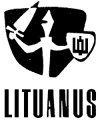Editor of this issue: Antanas Klimas
Copyright ę 1979 LITUANUS Foundation, Inc.

|
LITUANUS
LITHUANIAN QUARTERLY JOURNAL OF ARTS AND SCIENCES
Volume 25, No.4 - Winter 1979
Editor of this issue: Antanas Klimas ISSN 0024-5089
Copyright ę 1979 LITUANUS Foundation, Inc. |

|
Sven Ekdahl, Die "Banderia Prutenorum" des Jan D¨ugoszŚeine Quelle zur Schlacht bei Tannenberg 1410. Untersuchungen zu Aufbau, Entstehung and Quellenwert der Handschrift. G÷ttingen, Vandenhoeck & Ruprecht, 1976. [Abhandlungen der Akademie der Wissenschaften in G÷ttingen, Philologisch-historische Klasse, Dritte Folge, Nr. 104].
The battle of Tannenberg, 1410, in which the united forces of Lithuania and Poland totally defeated the German Teutonic Knights and their allies, and which effectively made the end to the German "Drang nach Osten" for almost 500 years, still attracts the attention of European scholars. Dr. Sven Ekdahl, a Swedish scholar, is at work on the history of this battle (cf. Vorwort, p. VII). He had been intrigued by the famous manuscript of Jan D¨ugosz which he saw at the Jagellonian Library during a visit in Cracow. This book grew out of that interest.
The "Banderia Prutenorum" (lit. "The Banners of the Prussians") is a manuscript o the middle of the 15th century which was, in part, written by the famous Polish historian and chronicler, Jan D¨ugosz. More importantly, perhaps, this monument entails paintings, or drawings, in well-preserved color, of the (military, battle) banners which were taken in that famous battle of Tannenberg (and someŚin later battles) from the Teutonic Knights, and which had been hanging for a very long time in the royal cathedral in Cracow. These drawings were made by the Polish painter Stanislaus Durink around 1449.
This book discusses, in great detail, the historic works of Jan D¨ugosz, and particularly his description of the battle of Tannenberg. It also compares this with the manuscript under discussion. Most importantly, I think, Sven Ekdahl, for the very first time, has photographed and published, in color, all the drawings of the banners, with various commentaries inscribed thereunto. The real manuscript size has been reduced by about one half, but the colors came out really splendidly, including the Latin commentaries of the THREE "Hands": IIIŚDurink, I-D¨ugosz, II-?.
The book is printed on high quality paper which helps to bring out and to preserve the color photographs. Many people and many institutions in several countries have contributed to the extensive research and the technical preparation of the manuscript, and of the printing of this book. Even the Swedish Crown has contributed funds. Although the price is not marked, it must be very expensive.
Although there had been in the past centuries, several full and several partial editions of the "Banderia Prutenorum", this will be the standard edition for a long time to come.
In the detailed discussion, Sven Ekdahl raises many interesting questions, important both for the history of Poland as well as for that of Lithuania and Germany. Moreover, many problems have to do with the history of warfare in Europe in the 15th century, and earlier. In this short review we cannot go into any more detailed discussion of these problems. However, I would like to mention at least the main conclusions (19. SchluBwort, pp. 155-157).
First of all, the author states that this manuscript had been overestimated, i. e., as to its intrinsic value for the history of warfare. Many things are impossible, on the basis of this manuscript alone, to evaluate. E. g., the number of combatants who had fought under this or that banner. Furthermore, in several cases, it is not even clear, in spite of the information written in by Durink and/or D¨ugosz, or the "II Hand", whether this particular banner did indeed, belong to the ascribed city, town, or castle.
Clearly, however, the "Banderia Prutenorum" is an important source for heraldry, cultural history, art history. (Durink was an important late medieval Polish painter, etc.).
Especially valuable, according to Ekdahl, is this manuscript for D¨ugosz-research. In short, it confirms the notion that D¨ugosz was trying to present Jagiello (Lith. Jogaila) as a rex iustus. On the other hand, D¨ugosz was trying to minimize the importance, and the role, of the Lithuanian army in the battle of Tannenberg.
No historian of that period will be able to work on these problems without reading this excellent book.
Antanas Klimas
The University of Rochester